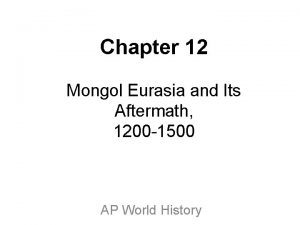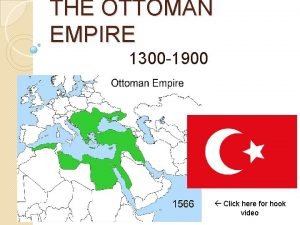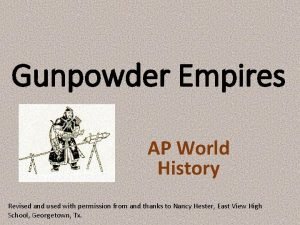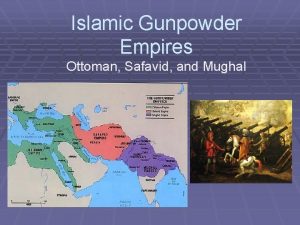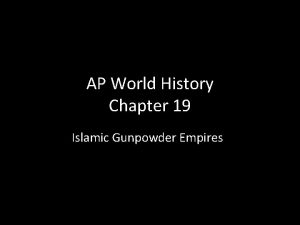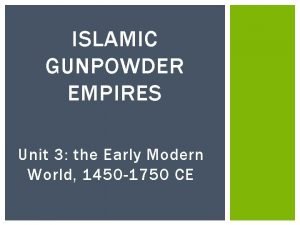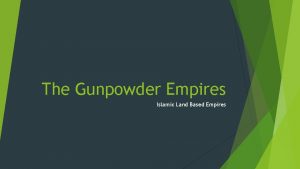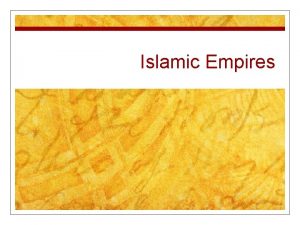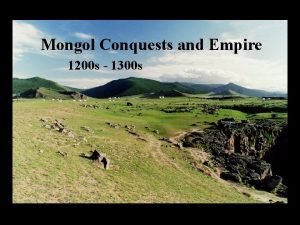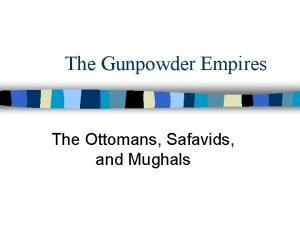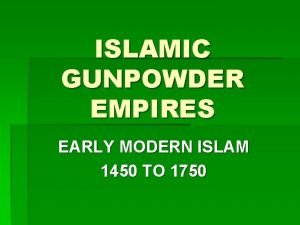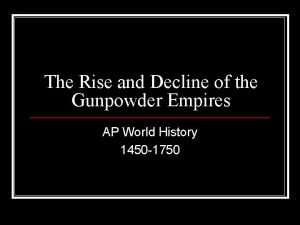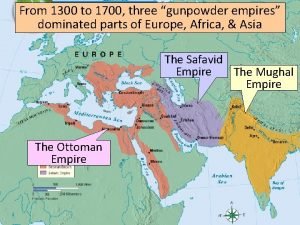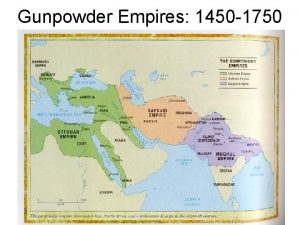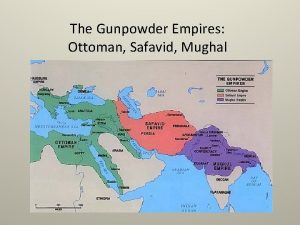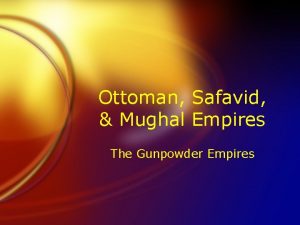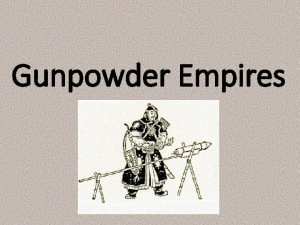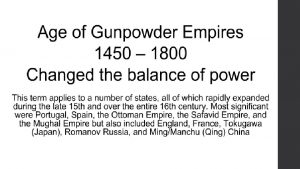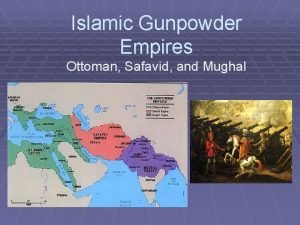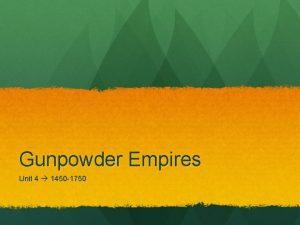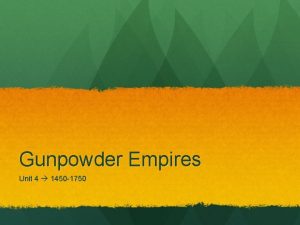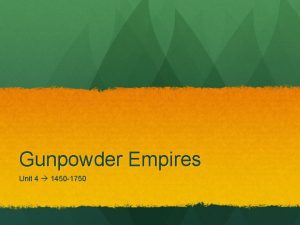Gunpowder Empires Ottoman Politics Important leaders Osman Mehmed














- Slides: 14

Gunpowder Empires

Ottoman: Politics • Important leaders: Osman, Mehmed II, Suleyman • Military ruling class • Janissaries • Devshirme • • Religious figures as political advisors (Sunni) Vizier stronger than the Sultan Absolute rulers Able monarchs • Tolerance shown to Dhimmis: commercial reasons • Elaborate court rituals: borrowed from Persian, Byzantine, Arabs • Weakness: no succession system

Economics and Culture • Restored glory of Constantinople • • Commerce thrived in early years of empire Large merchant and artisan classes Jews and Christians engaged as bankers & merchants Strong guild system to rival medieval Europe • Cultural achievements: • • • Hagia Sophia(example of monumental building) Aqueducts, rest houses, hospitals, schools Miniature paintings, rugs Coffee-houses Suleymaniye Mosque

Ottoman decline • Expansion ended by late 17 th century • Certain territories lost • Corrupt govot. Officials • Ill-prepared rulers • Refusal to advance military tech. • Portuguese trade diminished Ottoman dominance • Inflation of silver • Ottoman arrogance to European advancements

Safavid: Political structure • Important leaders: Sail-a-Din, Abbas The Great • Warrior nobility: similar to feudal Europe • Persian administrators at top levels • Slaves within military and government, became powerful • Used European advisors for military technique • Strong religious presence: Shia Islam • Utilized Persian language • Elaborate court rituals

Religion • Shi’a Islam • Became more radical over time • Pressure to convert • Became part of Iranian identity, not just political entity

Commerce & Culture • Abbas I: • • Built roads and resthouses Encouraged trade with Chinese & Europeans Built magnificent mosques Replicated Persian architecture

Safavid demise • Quality of rulers declined • Internal rebellions • Ottoman and Mughal pressure

Explain why the Battle of Chaldiran was so important • Took place in 1514 • Ottoman vs Safavids • Sunni vs Shi’a • Showed the importance of gunpowder • Allowed Ottoman to become most powerful Islamic state

Compare the society and gender roles of the Ottoman and Safavid • Dominated by warrior aristocracies • Harsh treatment towards peasants leads to uprisings • Breakdown of state-sponsored aid • Both empires patronized arts and monumental building • Sought to increase international trade (better achieved by Ottoman) • Safavid economy: more constricted, less market oriented, backward • Women: • Subordinate to men in family • Seclusion & veiling

Mughal Empire: • Important leaders: Babur, Akbar (Contemporaneous with Elizabeth I, Philip of Spain, Suleyman & Abbas) • Akbar • • • Built strong military machine Policy of cooperation with Hindu princes (intermarriage with Rajput rulers) Abolished jizya (head tax on Hindu) Promoted Hindu politicians to highest levels of govt Built new Hindu temples Social changes: banned sati, aid the poor, regulate alcohol, regulate purdah

Artistic achievement • Elaborate court ceremonies blending Indian and Persian culture • Game of polo • Taj Mahal • Indian cotton textiles (chintz, muslin) • Indian miniatures • However, fell behind in sciences and technology

Mughal Women • Strong willed wives: • Nur Jahan: wife of Shah Jahangir • Mumtaz Mahal: wife of Shah Jahann • Ordinary women’s status declined • • Child brides Sati reinstated Seclusion increased infanticide

Mughal Decline • Internal rebellions/corruption • Lacking military techniques • Falling living standards -> peasant uprisings • Strained alliances, overextended military • Hindu Prince revolts • Economic exploitation
 Ottoman empire gunpowder
Ottoman empire gunpowder Ottoman empire 1900
Ottoman empire 1900 Gunpowder ap world history
Gunpowder ap world history Islamic gunpowder empires ottomans safavids and mughals
Islamic gunpowder empires ottomans safavids and mughals Chapter 19 islamic gunpowder empires
Chapter 19 islamic gunpowder empires Empires
Empires Gunpowder empires map
Gunpowder empires map Gunpowder empires map
Gunpowder empires map Islamic gunpowder empires webquest
Islamic gunpowder empires webquest Map of gunpowder empires
Map of gunpowder empires Ottoman safavid and mughal empire map
Ottoman safavid and mughal empire map Ottoman, safavid, and mughal empires venn diagram
Ottoman, safavid, and mughal empires venn diagram Tamerlame
Tamerlame Decline of the gunpowder empires
Decline of the gunpowder empires 3 gunpowder empires
3 gunpowder empires
